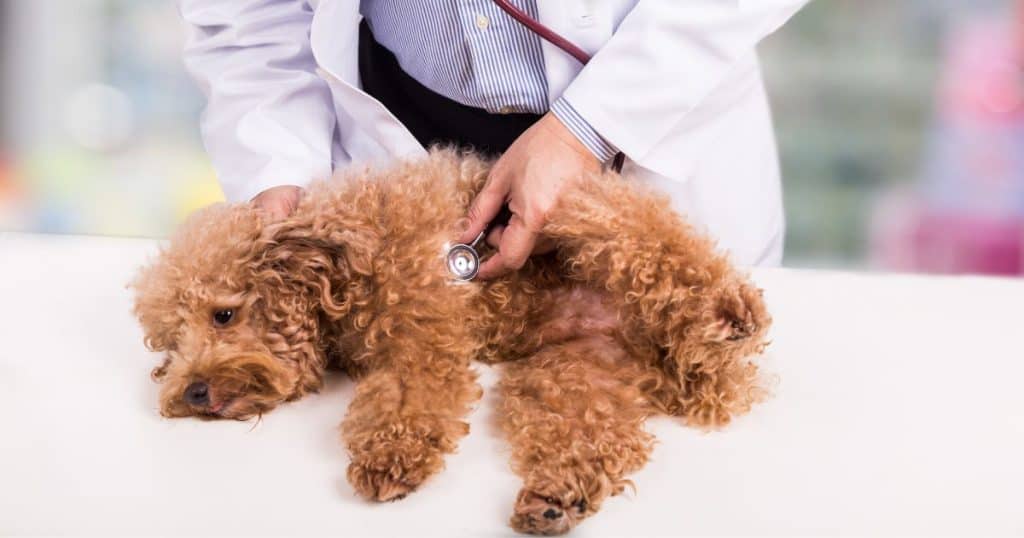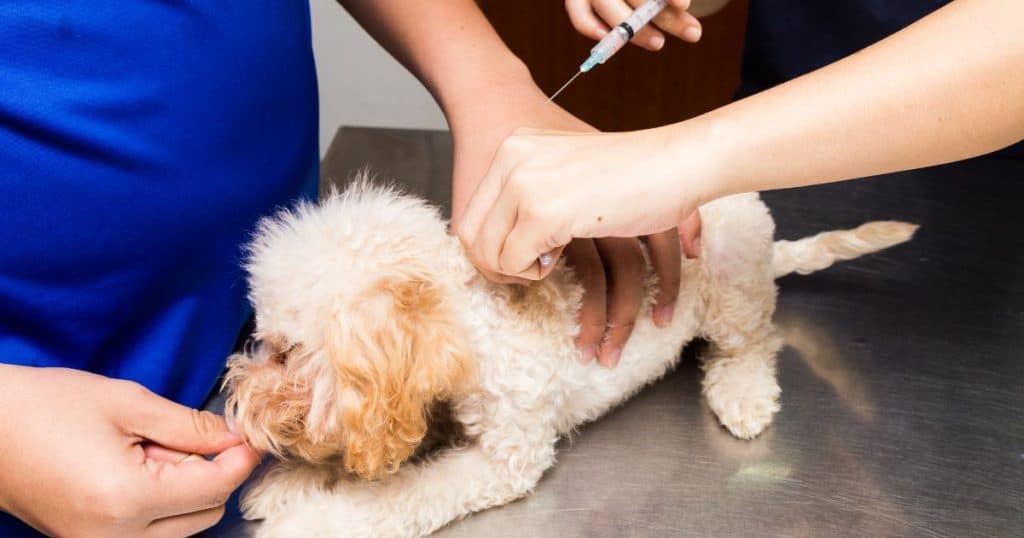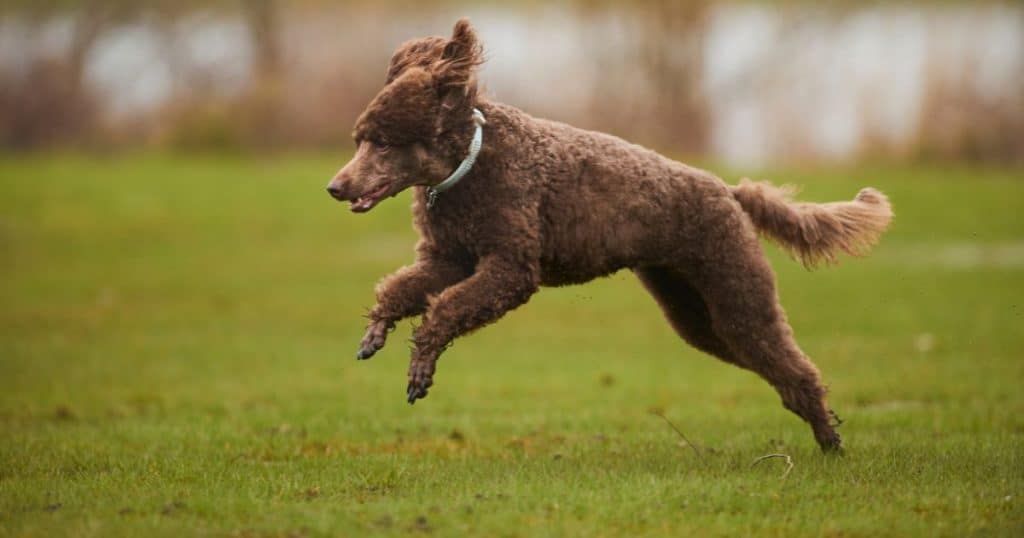Table of Contents
If you are a poodle owner, it is essential to know about hip dysplasia. Hip dysplasia is a common condition that affects the hip joints of dogs. Poodles are one of the breeds that are prone to hip dysplasia. It can cause pain, discomfort, and mobility issues in your furry friend.
Understanding the causes and symptoms of hip dysplasia is essential to take preventive measures and provide timely treatment. While hip dysplasia is not entirely preventable, you can reduce the likelihood of your poodle developing it by feeding a measured diet and developing a gentle exercise routine. Surgery and medication are available for treatment, but early detection is crucial for successful treatment.
Key Takeaways
- Hip dysplasia is a common condition that affects the hip joints of dogs, including poodles.
- Understanding the causes and symptoms of hip dysplasia can help take preventive measures and provide timely treatment.
- While hip dysplasia is not entirely preventable, feeding a measured diet and developing a gentle exercise routine can reduce the likelihood of your poodle developing it.
Understanding Poodle Hip Dysplasia

If you’re a poodle owner, you may be wondering what hip dysplasia is and how it affects your furry friend. Hip dysplasia is a common skeletal condition that can affect many breeds of dogs, including poodles. It occurs when the hip joint doesn’t develop properly, causing the ball and socket joint to not fit together correctly.
Standard poodles are particularly susceptible to hip dysplasia, as they are a larger breed of dog. Dysplastic poodles can experience a range of symptoms, from mild discomfort to severe pain. Some of the most common symptoms include difficulty standing up or walking, stiffness, and lameness in the hind legs.
Unfortunately, there is no one specific cause of hip dysplasia in poodles. However, it is believed to be a genetic condition that can be passed down from parent dogs to their offspring. If you’re considering getting a poodle, it’s important to research the breeder and their breeding practices to ensure that they are not breeding dogs with known hip problems in their pedigree.
If your poodle is diagnosed with hip dysplasia, there are several treatment options available. Mild cases may be treated with medication or weight management, while more severe cases may require surgery. In addition to these treatments, it’s important to develop a gentle exercise routine for your poodle to help reduce the likelihood of their condition worsening.
Overall, understanding poodle hip dysplasia is crucial for any poodle owner. By being aware of the symptoms and treatment options, you can help your furry friend live a happy and comfortable life.
Causes and Risk Factors

Hip dysplasia is a condition that affects many dogs, including Poodles. It is a complex condition that can be caused by both genetic and environmental factors. Understanding the causes and risk factors of hip dysplasia can help prevent and manage the condition in your Poodle.
Genetic Factors
Hip dysplasia is a hereditary condition that can be passed down from one generation of Poodles to the next. Poodles that have parents or other relatives with hip dysplasia are more likely to develop the condition themselves. This is because hip dysplasia is caused by an abnormal development of the hip joint, which is determined by a dog’s genes.
Breeders can reduce the risk of hip dysplasia in their Poodle puppies by carefully selecting breeding pairs that have good hip scores. Hip scores are a measure of the degree of hip dysplasia in a dog, and dogs with lower hip scores are less likely to pass on the condition to their offspring.
Environmental Factors
While genetics play a significant role in the development of hip dysplasia, environmental factors can also contribute to the condition. Excessive growth rate, types of exercise, improper weight, and unbalanced nutrition can magnify the genetic predisposition to hip dysplasia. Overfeeding your Poodle or allowing them to become overweight can put extra stress on their hip joints, increasing the risk of hip dysplasia. Similarly, exercising your Poodle too much or too vigorously at a young age can cause joint damage that can lead to hip dysplasia later in life.
To reduce the risk of hip dysplasia in your Poodle, it is important to provide them with a balanced diet and appropriate exercise. Avoid overfeeding your Poodle and make sure they get plenty of low-impact exercise, such as walking or swimming. It is also important to avoid breeding Poodles with known hip problems in their line.
By understanding the genetic and environmental factors that contribute to hip dysplasia, you can take steps to prevent and manage the condition in your Poodle. Regular veterinary check-ups and hip scoring can help detect hip dysplasia early, allowing for prompt treatment and management.
Signs and Symptoms

If you suspect your Poodle may have hip dysplasia, there are a few signs and symptoms to look out for. The most common clinical signs of hip dysplasia in dogs include stiffness, lameness, bunny hopping, and limping. Your Poodle may also exhibit reluctance to rise, climb stairs, or jump.
One of the most noticeable symptoms of hip dysplasia in Poodles is bunny hopping, which is when the dog uses both hind legs at the same time to move forward. This is because the dog is trying to avoid putting weight on the affected hip. Another symptom is stiffness, which can be especially noticeable when your Poodle first wakes up or after a period of rest.
Limping is another common symptom of hip dysplasia in Poodles. This can be intermittent or constant, and your dog may limp on one or both hind legs. Additionally, your Poodle may exhibit reluctance to rise, climb stairs, or jump. This is because these activities put extra strain on the hips and can be painful for dogs with hip dysplasia.
It’s important to note that not all dogs with hip dysplasia exhibit clinical signs. In some cases, dogs may have hip dysplasia but not show any symptoms until later in life. This is why it’s important to have your Poodle screened for hip dysplasia, especially if you plan on breeding them.
If you notice any of these signs or symptoms in your Poodle, it’s important to take them to the vet for an evaluation. Your vet can perform a physical exam and take X-rays to determine if your Poodle has hip dysplasia. Early detection and treatment can help manage the symptoms of hip dysplasia and improve your dog’s quality of life.
Diagnosis of Hip Dysplasia

Hip dysplasia is a common condition that affects many dogs, including Poodles. The diagnosis of hip dysplasia can be made through a combination of physical and radiographic examinations.
Physical Examination
During a physical examination, the veterinarian will look for signs of hip dysplasia such as lameness, pain, and decreased range of motion in the hip joints. The veterinarian may also perform a test called the Ortolani test, which involves manipulating the hip joint to check for laxity.
Radiographic Examination
Radiographic examination, or x-ray, is the most common method used to diagnose hip dysplasia. The veterinarian will take x-rays of the hips to evaluate the shape and position of the hip joint. The X-rays will show any abnormalities, such as shallow sockets or loose hip joints, that may indicate hip dysplasia.
It is important to note that hip dysplasia can be difficult to diagnose in young puppies, as their hip joints may not be fully developed yet. In some cases, a puppy may not show signs of hip dysplasia until they are older.
If your Poodle is diagnosed with hip dysplasia, it is important to work closely with your veterinarian to develop a treatment plan that will help manage the condition and improve your dog’s quality of life.
Treatment Options

If your poodle has been diagnosed with hip dysplasia, there are several treatment options available to help manage their pain and improve their quality of life. Treatment options for hip dysplasia in poodles can be broadly categorized into two groups: non-surgical treatments and surgical interventions.
Non-Surgical Treatments
Non-surgical treatments for hip dysplasia in poodles are typically the first line of treatment. These treatments focus on pain management and improving joint function.
Here are some non-surgical treatment options:
- Pain medications: Nonsteroidal anti-inflammatory drugs (NSAIDs) are commonly used to manage pain associated with hip dysplasia. Your veterinarian may prescribe NSAIDs such as carprofen or meloxicam to help manage your poodle’s pain.
- Nutritional supplements: Supplements such as glucosamine and chondroitin can help improve joint health and reduce inflammation. Your veterinarian may recommend a chewable supplement with a veterinarian-grade dose of glucosamine and chondroitin.
- Weight management: Maintaining a healthy weight can help reduce stress on your poodle’s joints. Your veterinarian can recommend a healthy diet and exercise plan to help your poodle maintain a healthy weight.
- Physical therapy: Physical therapy can help improve joint function and reduce pain. Your veterinarian may recommend exercises such as swimming or walking on a treadmill to help improve your poodle’s joint function.
Surgical Interventions
If non-surgical treatments are not effective in managing your poodle’s pain and improving joint function, your veterinarian may recommend surgical intervention.
Here are some surgical treatment options:
- Total hip replacement: Total hip replacement is a surgical procedure that involves replacing the hip joint with an artificial joint. This procedure can help improve joint function and reduce pain.
- Triple pelvic osteotomy: Triple pelvic osteotomy is a surgical procedure that involves cutting and repositioning the bones in the pelvis to improve joint function and reduce pain.
- Juvenile pubic symphysiodesis: Juvenile pubic symphysiodesis is a surgical procedure that is performed on young puppies to help prevent hip dysplasia from developing.
It is important to note that surgical intervention is typically reserved for severe cases of hip dysplasia and should only be considered after non-surgical treatments have been exhausted.
In conclusion, there are several treatment options available for poodles with hip dysplasia. Non-surgical treatments such as pain medications, nutritional supplements, weight management, and physical therapy can help manage pain and improve joint function. If non-surgical treatments are not effective, surgical intervention may be necessary. Your veterinarian can help determine the best course of treatment for your poodle based on their individual needs.
Prevention and Management

Hip dysplasia is a genetic condition that affects many dog breeds, including Poodles. Although it is not entirely preventable, there are steps that owners can take to reduce the likelihood of their Poodle developing hip dysplasia. In this section, we will discuss weight management, exercise, and physical therapy as ways to prevent and manage hip dysplasia in Poodles.
Weight Management
Maintaining a healthy weight is essential for preventing hip dysplasia in Poodles. Obesity can put extra pressure on the hip joints, leading to the development of hip dysplasia. Therefore, it is crucial to feed your Poodle a measured diet and avoid overfeeding. Consult with your veterinarian to determine the appropriate amount of food for your Poodle’s size and age.
Exercise and Physical Therapy
Regular exercise is essential for keeping your Poodle’s muscles strong and healthy. However, it is important to avoid high-impact activities like jumping or running up stairs, as they can put strain on the hip joints. Instead, opt for low-impact exercises like walking, swimming, or gentle playtime.
Physical therapy can also be beneficial for managing hip dysplasia in Poodles. Therapeutic exercises and massages can help improve range of motion, reduce pain, and strengthen muscles. Consult with your veterinarian or a certified canine rehabilitation therapist for guidance on appropriate physical therapy exercises for your Poodle.
In conclusion, weight management, exercise, and physical therapy are all important factors in preventing and managing hip dysplasia in Poodles. By following these guidelines, you can help keep your Poodle healthy and happy for years to come.
Prognosis and Quality of Life

Hip dysplasia is a condition that can significantly affect a Poodle’s quality of life. The severity of the disease can range from mild to severe, and the prognosis varies depending on the severity of the disease and the age of the dog.
In mild cases, the dog may not show any clinical signs, and the prognosis for a normal life is excellent. However, in more severe cases, the dog may develop arthritis, inflammation, and osteoarthritis, which can lead to chronic pain and mobility issues.
If left untreated, hip dysplasia can lead to degenerative joint disease, which can cause the dog to lose mobility and become less active. In severe cases, the dog may require surgery to repair or replace the hip joint.
The good news is that with proper treatment, many dogs with hip dysplasia can lead normal, happy lives. Treatment options include weight management, exercise modification, pain management, and surgery.
Weight management is critical for dogs with hip dysplasia, as excess weight can put additional stress on the joints. Exercise modification is also essential, and low-impact activities such as swimming and walking on soft surfaces can help maintain muscle mass and improve joint mobility.
Pain management is also crucial for dogs with hip dysplasia. Medications such as nonsteroidal anti-inflammatory drugs (NSAIDs) and joint supplements can help reduce inflammation and pain. In severe cases, surgery may be necessary to repair or replace the hip joint.
Overall, the prognosis for Poodles with hip dysplasia depends on the severity of the disease and the age of the dog. With proper treatment and management, many dogs with hip dysplasia can lead normal, happy lives. However, it is essential to work closely with your veterinarian to develop a treatment plan that works best for your dog.
FAQs
What are the first signs of hip dysplasia in Poodles?
Hip dysplasia in Poodles can be difficult to detect in its early stages, as it is a progressive disease that worsens over time. However, some common signs to look out for include difficulty getting up or lying down, reluctance to climb stairs or jump, limping, and a decreased range of motion in the hips. If your Poodle is exhibiting any of these symptoms, it’s important to take them to a veterinarian for a proper diagnosis.
How do I know if my Poodle has hip dysplasia?
The best way to know for sure if your Poodle has hip dysplasia is to have them evaluated by a veterinarian. Your vet will perform a physical examination and may also recommend x-rays or other imaging tests to confirm the diagnosis. If your Poodle is diagnosed with hip dysplasia, your vet can also help you develop a treatment plan to manage their condition.
Is hip dysplasia common in Standard Poodles?
Hip dysplasia is a common condition in many large dog breeds, including Standard Poodles. While not all Poodles will develop hip dysplasia, it is important to be aware of the signs and symptoms and to take your dog to the vet if you suspect they may be suffering from this condition.
How to prevent hip dysplasia in Poodles?
While there is no surefire way to prevent hip dysplasia in Poodles, there are some steps you can take to reduce your dog’s risk of developing this condition. One of the most important things you can do is to maintain a healthy weight for your Poodle, as obesity can increase the likelihood of hip dysplasia. You can also provide your dog with regular exercise and a balanced diet, and consider feeding them a joint supplement to support their joint health.
How do you treat hip dysplasia in a Toy Poodle?
The treatment for hip dysplasia in a Toy Poodle will depend on the severity of the condition. In mild cases, your vet may recommend weight management, exercise modification, and joint supplements to manage your dog’s symptoms. In more severe cases, surgery may be necessary to correct the problem. Your vet can help you determine the best course of treatment for your Toy Poodle.
How long can a Poodle live with hip dysplasia?
The lifespan of a Poodle with hip dysplasia will depend on a variety of factors, including the severity of the condition and the quality of care they receive. While hip dysplasia can be a painful and debilitating condition, many dogs are able to live long and happy lives with proper treatment and management of their symptoms. If you suspect that your Poodle may be suffering from hip dysplasia, it’s important to seek veterinary care as soon as possible to help manage their condition and improve their quality of life.




Leave a Reply
You must be logged in to post a comment.